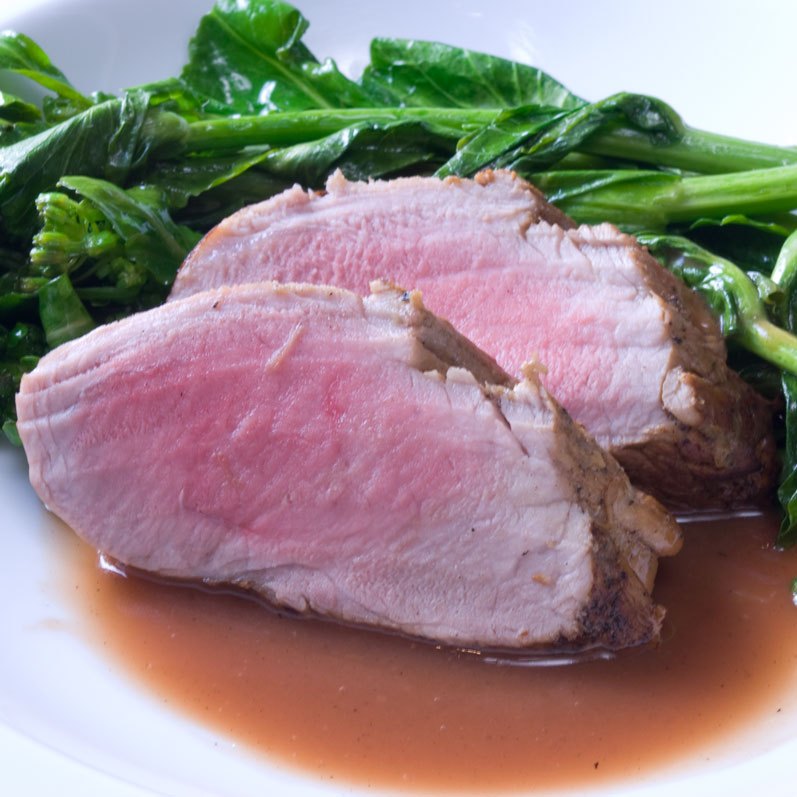Apple Cider-Brined Tenderloin of Pork with Rhubarb Deglazing Sauce
The sweet flavor of pork has a natural affinity with acidic fruit flavors, as in this rhubarb-cider sauce, and with spices, such as allspice and cloves, which are used here in an apple cider brine. The key to this dish is in not overcooking the pork; it should be nicely rosy in the center, very juicy and tender. And yes, it is quite safe to eat it this way and so much preferable to the dried-out, stringy stuff we are so often served in the name of pork.
 2 whole pork tenderloins (preferably about 9 oz. each and 9-inches long)
2 whole pork tenderloins (preferably about 9 oz. each and 9-inches long)
2 C. apple cider
1 tsp. fine sea salt
1 tsp. sugar
½ cinnamon stick, broken
1 tsp. whole allspice
½ tsp. whole cloves
2 C. trimmed, diced rhubarb
2 tsp. brown sugar
1 C. low-salt chicken stock
1 C. apple cider
1 tsp. unsalted butter
1 tsp. cold pressed olive oil
2 tsp. balsamic vinegar
½ C. low-salt chicken stock
fine sea salt, to taste
freshly ground black pepper, to taste
sugar, to taste
Trim all fat from the tenderloins and reserve. To brine the pork, in a mixing bowl, combine the brine ingredients, and stir until the salt and sugar dissolve. Place the tenderloins in a glass baking dish and pour the brine over them. Seal tightly with plastic wrap and refrigerate for at least 6 hours or overnight. Rotate the tenderloins once or twice while brining. To make the sauce, in a small saucepan, combine the rhubarb and brown sugar, and let sit for 1 hour. Add 1 C. chicken stock and apple cider. Cook until rhubarb is actually disintegrating. Into a large measuring glass measuring C., strain the sauce, pushing against the solids to extract as much of the liquid as possible. Reserve. Remove tenderloins from the brine and pat dry with paper towels. Discard the brine. In a large sauté pan, heat the butter and olive oil. Lay the tenderloins in the pan and brown deeply on all sides. (It’s fine to cut the tenderloins if they are too long for the pan.) This process usually requires about 8-10 minutes. Do this quickly so that the pork doesn’t cook all the way through. Drain the fat from the sauté pan, and add the vinegar and ½ C. stock to the pan to deglaze. Cover the pan and braise slowly (just a bubble on the surface) until the internal temperature of the pork reads 145 degrees, about 12-18 minutes. (Pork is judged safe to eat at 137 degrees, but it is advisable to cook it somewhat beyond this point to be sure.) When the pork is done, remove from the pan and keep warm for a few minutes. Raise the heat and add the rhubarb sauce. Whisk and cook until thickened; the sauce should just coat a wooden spoon. (If desired, you can make a slurry with a tsp. cornstarch and a tsp. stock and use it to thicken the sauce slightly.) Taste and then carefully season the sauce with salt, pepper, and additional sugar if needed. Strain sauce into a small saucepan. Keep warm. Cut the tenderloin into 3/4-inch medallions, arrange on one side of four individual warmed serving plates and pour the sauce under and around. If desired, serve with a quick braise of rapini or baby vegetables, such as turnips, parsnips, and carrots.